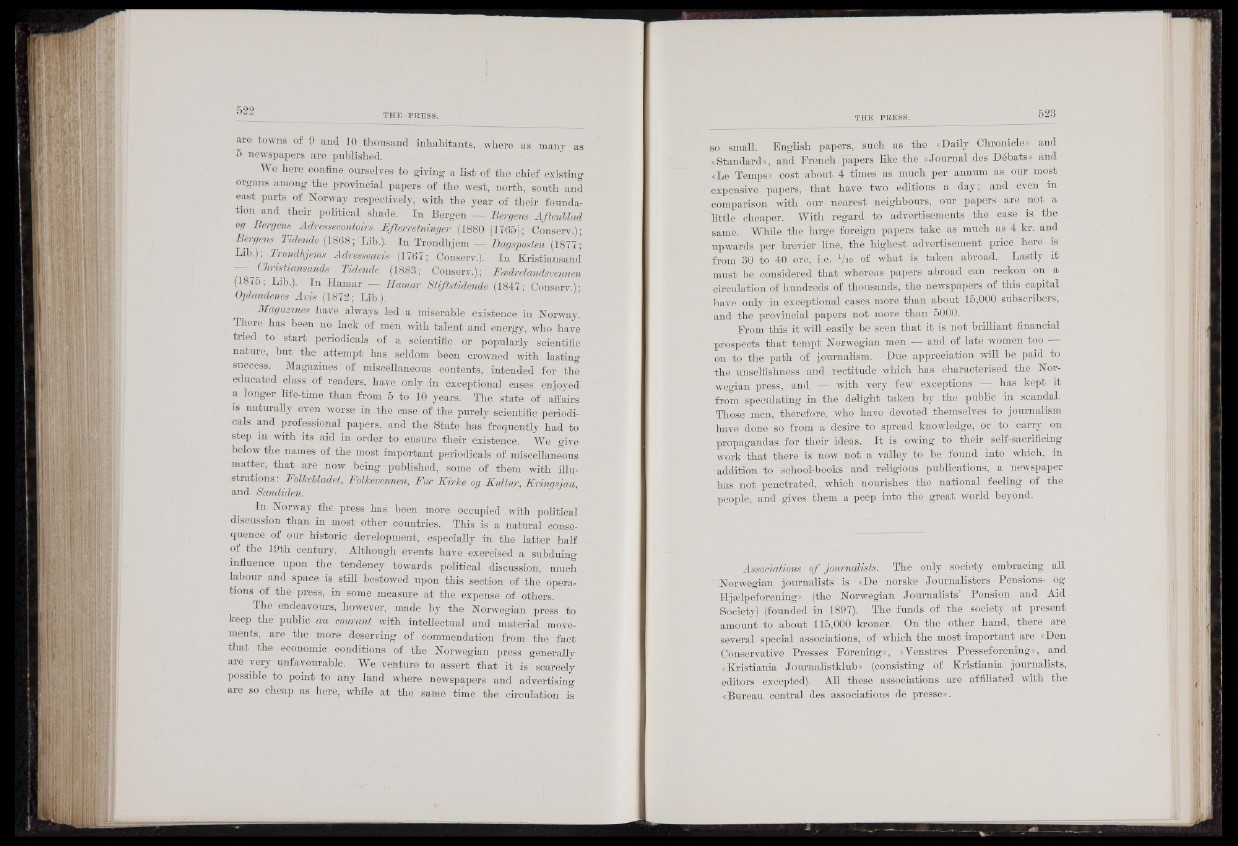
are towns of 9 and 10 thousand inhabitants, where as manjúas
5 newspapers are published.
We here confine ourselves to giving a list of the chief existing
organs among the provincial papers of the west, north, south and
east parts of Norway respectively, with the year of their foundation
and their political shade. In Bergen -4- Bergens AftenUad
og Bergens Adresseeontoirs Efterretninger (1880 [1765]-; Conserv.);
Bergens Tidende (1868; Lib.). In Trondhjem gf Dagsposten (1877;
Lib.); Trondhjems Adresseavis: (1767; Conserv.). In Kristiansand
— Christiapsands Tidende (1883; Conserv.); Fcedrelandsvennen
(1875; Lib.). In Hamar WmHamar Stiftstidende (1847; Conserv!;-
Oplandenes Avis (1872; Lib.).
Magazines have always led a miserable existence in Norway.
There has been no lack of men with talent and energy, who have
tried to start periodicals of a scientific or popularly scientific
nature, but the attempt has seldom been crowned with lasting
success. Magazines of miscellaneous contents, intended for the
educated class of readers, have only in exceptional cases enjoyed
a longer life-time than from 5 to 10 years. The state o f . affairs
is naturally even worse in the case of the purely scientific periodicals
and professional papers, and the State has frequently had to
step in with its aid in order to ensure their existence. We give
below the names of the most important periodicals of miscellaneous
matter, that are now being published, some of them with illustrations
: FolJcebladet, FolJcevennen, For Kirie og Kultur, Kringsjaa,
and Samtiden.
In Norway the press has been more Occupied with political
discussion than in most other countries. This is a natural consequence
of our historic development, especially in the latter half
of the 19th century. Although events have exercised a subduing
influence upon the tendency towards political discussion, much
labour and space is still bestowed upon this section of the. operations
of the press, in some measure at the expense of others.
The endeavours, however, made by the Norwegian press to
keep the public au eourant with intellectual and material movements,
are the more deserving of commendation from the fact
that the economic conditions of the Norwegian press generally
are very unfavourable. We venture to assert that it is scarcely
possible to point tó any land where newspapers and advertising
are so cheap as here, while at the same time the circulation is
so small. English papers, such as the «Daily Chronicle» and
«Standard», and French papers like the «Journal des Débats» and
«Le Temps'» • cost about 4 times as much per annum as our most
expensive papers, that have two editions a day; and even in
comparison with our nearest neighbours, our papers aré not a
little cheaper. With regard to advertisements the case is the
same. While the large foreign papers take as much as 4 kr. and
upwards per brevier line, the highest advertisement price here is
from 30 to 40 ore, i.e. Vio: of what is taken abroad. Lastly it
must be considered that whereas papers abroad can reckon on a
circulation of hundreds of thousands, the newspapers of this capital
have only in exceptional cases more than about 15,000 subscribers,
and the provincial papers not more than 5000.
From this it will easily be seen that it is not brilliant financial
prospects that tempt Norwegian men^-f^and of late women too —
on to the path of journalism. Due appreciation will be paid to
the unselfishness and rectitude which has characterised the Norwegian
press, and i t with very few exceptions W S has kept it
from speculating in the delight taken by the public in scandal.
Those men, therefore, who have devoted themselves to journalism
have done so from a desire to spread knowledge, or to carry on
propagandas for their ideas. I t is owing to their self-sacrificing
work that there is now not a valley to be found into which, in
addition to school-books and religious publications, a newspaper
has not penetrated, which nourishes the national feeling of the
people, and gives , them a peep into the great world beyond.
Associations of journalists. The only society embracing all
Norwegian journalists is «De norske Joumalisters Pensions- og
Hjeelpeforening» (the Norwegian Journalists’ Pension and Aid
Society) .(founded in 1897). The funds of the society at present
amount to about 115,000 kroner. On the other hand, there are
several special associations, of which the most important are «Den
Conservative Presses Forening», »Venstres Presseforening», and
«Kristiania Joumalistklub» (consisting' of Kristiania journalists,
editors excepted). All these associations are affiliated with the
«Bureau central des associations de presse».